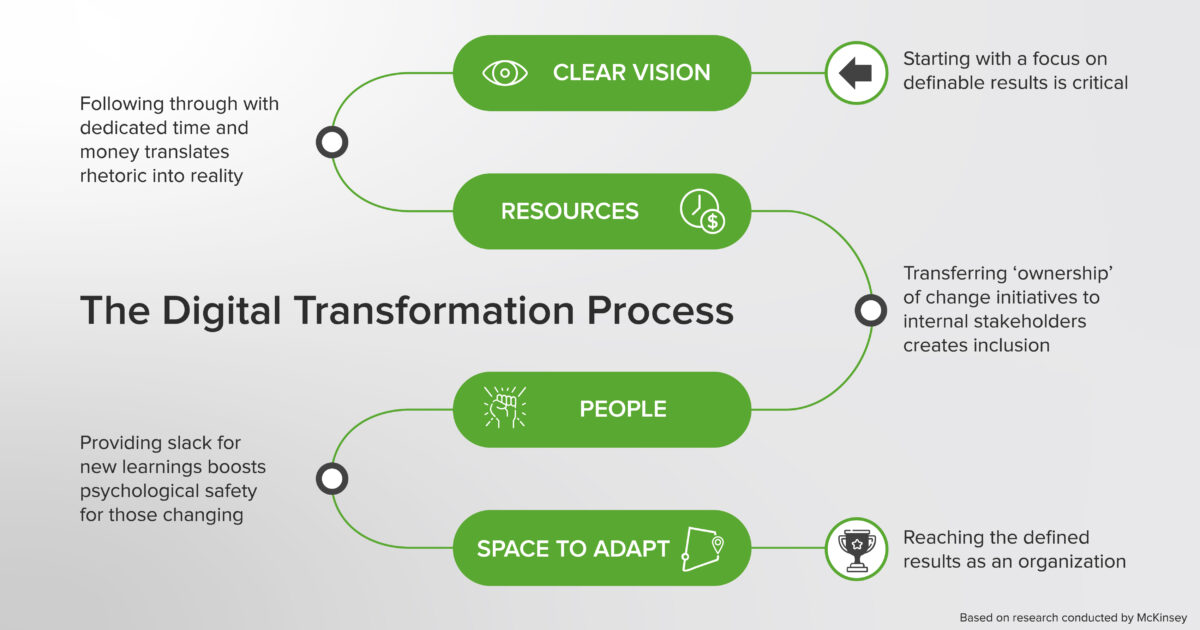What Does Digital Transformation in Medical Education Mean for Medical School Leaders?
The majority of medical school leaders already understand that digital technology can significantly improve the performance of their current education models and that we are right in the middle of a powerful digital revolution. However, the recognition that digital technology can allow entirely new educational models that are more effective, efficient, resilient, and adaptive is less widespread. Therefore, the knowledge gap can leave schools that fail to adopt these technologies in a transformative way struggling to meet the evolving needs of both their environments and individual students.
The implementation of these transformative digital technologies can be a crucial component of ensuring that a school’s approach to teaching, enhancement of learning outcomes, and support of students and faculty remain competitive and viable. However, one of the hardest and most enduring parts of a successful digital transformation is actually not the technological component, but rather the cultural component. Cultural transformation in a medical school with an entrenched organizational culture can be a particularly difficult challenge for medical school leaders to overcome.
Why Must Medical Education Change?
The status quo is no longer sufficient
Medical education itself has been historically slow at adapting to digital technology’s impact. The global COVID-19 pandemic has accelerated and highlighted this transformation – and the pressure is mounting.
It has been reality for many years that incoming medical students are digital natives already attuned to and, in fact, already demanding digital technologies. The subsequent expectations and practices of these students are often very different from the traditional teaching and learning methodologies of established medical schools. Moreover, long-held beliefs and techniques concerning study habits are increasingly being shown to be unhelpful, or even counterproductive, in the learning process.
The result is that not only is the digital divide between students and universities growing, but the learning divide between tradition and science is also expanding. Today’s medical educators are thus faced with the challenge of integrating more complex and durable learning modalities into their teaching while working with an often outdated set of pedagogic tools. In order to come to terms with the latest developments in learning science, a paradigm shift in the way medicine is taught is essential.
The traditional teaching model has changed little

Digital transformation is already underway
Constant advances in medicine and medical technology are generating exponential increases in the amount of scientific knowledge that must be mastered for a complete medical education. This poses unprecedented challenges for modern medical students, as well as for today’s educators and medical institutions as a whole. Helping students tackle this exponential increase in the amount of knowledge and sources they need to master in the first years of medical school is perhaps the greatest challenge educators face.
This phenomenon leads medical students to turn to more digital resources, such as YouTube and Wikipedia, to supplement their university learning resources. However, these resources have few (if any) quality controls, and therefore carry their dangers. Medical schools are now forced to compete with technology companies such as Google to retain their status as the go-to educational resource. As the world of medical education continues its digital transformation, medical schools must welcome and embrace innovation. This includes, most importantly, remaining involved in securing properly-reviewed and reliable resources for their students.
Medical students have already completed the transformation to rich digital content

Evidence-Based Medical Education as the Goalpost, Digital Transformation as Just the Enabler
Medical educators often think of ‘evidence-based medicine’ when one speaks of ‘evidence-based medical education.’ However, these are not the same thing. What is meant by ‘evidence-based medical education’ is that the manner in which medicine is taught should be evidence-based, or grounded in learning science.
While introducing technology can create substantial accessibility, searchability, affordability and other fairly immediate and obvious benefits, the key overall guiding star for any reconfiguration should be the learning science evidence and the goal to create a more effective teaching process – one that creates better doctors, with better mastery of the key concepts and the ability to apply them – rather than exam scores achieved with extensive cramming and a lot of forgetting in the weeks or months that follow.
Reading up on learning science, e.g. “Make It Stick” (by Peter C Brown, Mark A. McDaniel, and Henry L. Roediger III) and “Powerful Teaching: Unleash the Science of Learning” (by Pooja K. Agarwal and Patrice M. Bain), will make sure that digital transformation efforts become enablers for more evidence-based education delivery rather than ‘digitization for its own sake.’
How to Master Digital Transformation as a Medical School Leader
“Change management has been the greatest challenge with students of the 21st century, faculty from the 20th century, and educational models from the mid-century.”
– Dr. Joaquín Guerra Achem, Vice-President for Educational Innovation & Academics at Tecnológico de Monterrey School of Medicine and Health Sciences
Lecturio recently conducted interviews with medical school leaders around the world, which showed that cultural change management, specifically within the context of digital transformation, is the most common challenge facing medical education leaders today. The good news is that leaders can significantly increase the chance that a transformation focused on the digital enhancement of medical pedagogy will succeed by following best practice approaches.
Lecturio identified that adhering to the following well-defined transformation practices will help set you up for success:
- Defining a clear vision & communicating it: In digital transformation, focusing on a few clear themes that are tied directly to concrete results is critical. Communicating the benefits to various groups of stakeholders is important; faculty, students, and administrators are important stakeholders to bear in mind. Outlining and explaining the downsides to not adopting new approaches is also important when emphasizing the imperative to change.
- Identify and allocate sufficient resources: Even with a clear vision, medical school leaders can find it difficult to sustain their focus on digital enablement. They must dedicate the time, money and manpower the process requires. Recruiting internal change agents who have the necessary time and influence to bring about change is vital.
- Empowering people: Digital transformation is more likely to succeed when a sense of ‘ownership’ is instilled across all stakeholder groups. Assigning clear roles and responsibilities to stakeholders, as well as allowing them a degree of self-direction through structured processes, is critical to creating this sense of ‘ownership.’ Incorporating administrators, faculty, and students in the transformation, and allowing their voices to be heard, creates a culture of inclusion required to implement lasting change.
- Creating a safe space to adapt: Establishing psychological safety for those affected by change is a hallmark of successful change management. As a professional, making mistakes can be really difficult, but it is a part of the (un)learning process. Reassuring stakeholders that support is available and that they will continue to be needed is key to maintaining a positive spirit throughout the change process.
Fundamentally, digital transformation goes hand in hand with changing the mindsets of organizational stakeholders – again, it’s about cultural transformation. This is because most digital technologies, even when implemented correctly, provide only the possibility for efficiency and quality gains. But if medical school administrators and faculty lack the understanding, will, and ‘professional safety’ necessary for digital transformation, those shortcomings can turn into inefficiencies.
Digital transformation works within medical schools when their leaders focus on changing the organizational culture and management processes before they decide which digital tools to use and how to use them. What the stakeholders envision to be the future of the medical school drives the technology, not the other way around.

